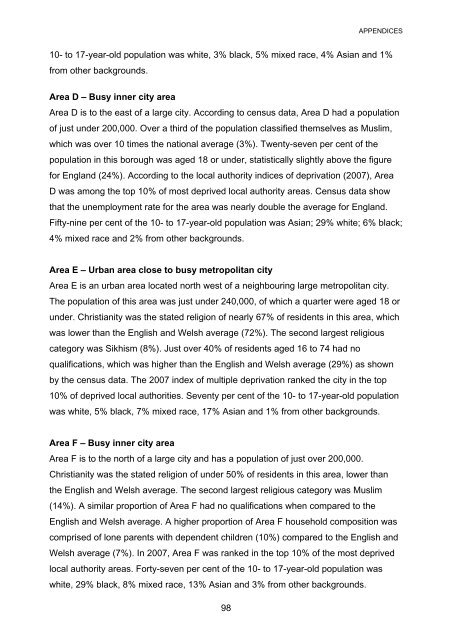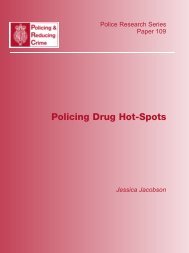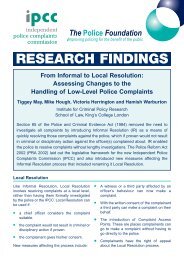Differential treatment in the youth justice system - Equality and ...
Differential treatment in the youth justice system - Equality and ...
Differential treatment in the youth justice system - Equality and ...
Create successful ePaper yourself
Turn your PDF publications into a flip-book with our unique Google optimized e-Paper software.
APPENDICES10- to 17-year-old population was white, 3% black, 5% mixed race, 4% Asian <strong>and</strong> 1%from o<strong>the</strong>r backgrounds.Area D – Busy <strong>in</strong>ner city areaArea D is to <strong>the</strong> east of a large city. Accord<strong>in</strong>g to census data, Area D had a populationof just under 200,000. Over a third of <strong>the</strong> population classified <strong>the</strong>mselves as Muslim,which was over 10 times <strong>the</strong> national average (3%). Twenty-seven per cent of <strong>the</strong>population <strong>in</strong> this borough was aged 18 or under, statistically slightly above <strong>the</strong> figurefor Engl<strong>and</strong> (24%). Accord<strong>in</strong>g to <strong>the</strong> local authority <strong>in</strong>dices of deprivation (2007), AreaD was among <strong>the</strong> top 10% of most deprived local authority areas. Census data showthat <strong>the</strong> unemployment rate for <strong>the</strong> area was nearly double <strong>the</strong> average for Engl<strong>and</strong>.Fifty-n<strong>in</strong>e per cent of <strong>the</strong> 10- to 17-year-old population was Asian; 29% white; 6% black;4% mixed race <strong>and</strong> 2% from o<strong>the</strong>r backgrounds.Area E – Urban area close to busy metropolitan cityArea E is an urban area located north west of a neighbour<strong>in</strong>g large metropolitan city.The population of this area was just under 240,000, of which a quarter were aged 18 orunder. Christianity was <strong>the</strong> stated religion of nearly 67% of residents <strong>in</strong> this area, whichwas lower than <strong>the</strong> English <strong>and</strong> Welsh average (72%). The second largest religiouscategory was Sikhism (8%). Just over 40% of residents aged 16 to 74 had noqualifications, which was higher than <strong>the</strong> English <strong>and</strong> Welsh average (29%) as shownby <strong>the</strong> census data. The 2007 <strong>in</strong>dex of multiple deprivation ranked <strong>the</strong> city <strong>in</strong> <strong>the</strong> top10% of deprived local authorities. Seventy per cent of <strong>the</strong> 10- to 17-year-old populationwas white, 5% black, 7% mixed race, 17% Asian <strong>and</strong> 1% from o<strong>the</strong>r backgrounds.Area F – Busy <strong>in</strong>ner city areaArea F is to <strong>the</strong> north of a large city <strong>and</strong> has a population of just over 200,000.Christianity was <strong>the</strong> stated religion of under 50% of residents <strong>in</strong> this area, lower than<strong>the</strong> English <strong>and</strong> Welsh average. The second largest religious category was Muslim(14%). A similar proportion of Area F had no qualifications when compared to <strong>the</strong>English <strong>and</strong> Welsh average. A higher proportion of Area F household composition wascomprised of lone parents with dependent children (10%) compared to <strong>the</strong> English <strong>and</strong>Welsh average (7%). In 2007, Area F was ranked <strong>in</strong> <strong>the</strong> top 10% of <strong>the</strong> most deprivedlocal authority areas. Forty-seven per cent of <strong>the</strong> 10- to 17-year-old population waswhite, 29% black, 8% mixed race, 13% Asian <strong>and</strong> 3% from o<strong>the</strong>r backgrounds.98






